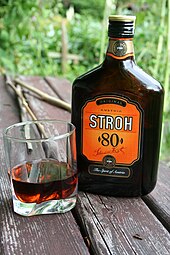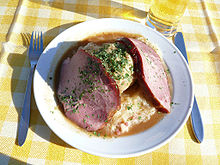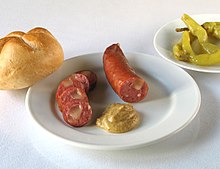Austrian kitchen

The Austrian cuisine has many regional variations. In addition to the Viennese cuisine which are predominantly in the culinary tradition of the Austro-Hungarian monarchy of Austria-Hungary is, there are distinct regional traditions in all federal states . There you will also often find pan-fried dishes, dumpling variations, thick soups and stews on the tables.
The Austrian cuisine shows influences from all regions of the Austro-Hungarian monarchy, especially from Hungary, Bohemia and Northern Italy, but also from France. Dishes and methods of preparation were adopted, integrated and adapted from there. Goulash is an example . Austrian cuisine is internationally known for its pastries such as Kaiserschmarrn as well as for boiled beef and Wiener schnitzel as well as gypsy schnitzel .
Regional cuisines
Vienna
Contrary to the cuisine in the federal states, which uses a lot of down-to-earth recipes and foods, the Viennese cuisine was strongly influenced by the different kitchens of the crown lands .
Lower Austria
In Lower Austria specialties such as Waldviertel poppy seeds ( poppy seed noodles ), Marchfeld asparagus and Wachau apricots are grown, which have found their way into the kitchen, such as B. Poppy seed noodles. Game dishes are quite common.
Lower Austria in particular is characterized by different regional kitchens due to the differences in landscape and its size, although - due to the geographical proximity and shared history - many “Viennese dishes” can be found in the inns. This applies above all to the area of the Vienna Basin. The Saumaise is a Waldviertel specialty .
Burgenland
Due to the long membership of the Hungarian part of the Austrian monarchy, the cuisine of Burgenland is influenced by the Hungarian cuisine . Dishes mostly consist of fish ( Fogosch from Lake Neusiedl ), chicken ( paprika chicken ) or goose such as B. the foie gras. Other typical dishes are cabbage roulade , cabbage soup, fish soup , stuffed peppers , letscho , grenadier march , bean and cabbage strudel. A martini goose is often prepared for the feast of St. Martin on November 11th . Grammelpogatscherl are served with the wine. Dishes formerly often consumed by the poorer classes, such as “Mülifoafal”, a milk-based farferl soup with flour dumplings, which, according to Franz Maier-Bruck, has long been considered a kind of national dish of the Burgenland ( “Hienzen” ), disappeared after the Second World War with the increasing prosperity almost entirely from the menu of the Burgenland.
Styria
A typical Styrian specialty is pumpkin seed oil , which is particularly suitable for salads due to its nutty taste , such as potato salad , the Styrian beetle bean salad , for a fried chicken or beef salad. The pumpkin seed oil is also used as an ornament for the classic Styrian pumpkin soup . Because pumpkin dishes are very popular in Styria in many variations, for example as a side dish with Weizer mountain lamb or as baked pumpkin slices with grain breading .
Overall, the Styrian cuisine is characterized by traditional poor people's food, such as Heidensterz , a Schmarrn made from buckwheat flour , which is now considered a specialty for cold days. Hearty meat dishes, nutritious and easy to prepare, such as the Ritschert , the bucket meat or the Styrian root meat dominate the popular cuisine . The Styrian fried chicken is the equivalent of the Wiener Schnitzel . Like the root meat, it is now enjoying great popularity in other federal states. In addition, there are a variety of regional specialties, such as a "Aufsetzt Henn", a filled Sulmtaler chicken.
The Steirerkäse is a low-fat cheese that already bears the name of the federal state, there are two types, the Ennstaler and the Murtalersteirerkas. In the taverns Brettl snacks are with bacon jam (a spread of finely chopped bacon), smoked, dried sausages, cheese, Kernölaufstrich and Liptauer served on wooden plates. The traditional Styrian fast food is the Krainerwürstl , the name of which goes back to the former Kronland and Duchy of Krain .
Schilcher is a regional wine from West Styria, a very dry rosé made from the Blauer Wildbacher grape variety. In addition to the long winemaking tradition, there is also a long brewing tradition with the three classic brands Gösser and Murauer from Upper Styria and Puntigamer from Graz, whose origins go back to the 15th century.
Carinthia
In Carinthia, which is rich in lakes, people like to eat fish. Important components of the Carinthian cuisine are grain, dairy products and meat. A well-known specialty are the Carinthian Kasnudeln ( dumplings filled with curd cheese and brown mint ) and the smaller Schlickkrapfen (sometimes called Schlipfkrapfen) mostly with meat filling. Ritschert , a stew made from beans and barley, can even be traced back to Celtic times. There are also specialties such as Klachlsuppe , Kirchtagssuppe , Frigga or Reindling .
Upper Austria
As in neighboring Bavaria and Bohemia, dumplings in various preparations and with numerous savory fillings ( meat dumplings ) are an important element of Upper Austrian cuisine. Bratl (especially surbratl), spare ribs, vinegar sausage, mason trout (crackers with onions ), sulz and the so-called Brettljause (various types of sausage, meat and cheese garnished with cucumber, mustard, etc. on a snack board) are popular in Upper Austria eaten. A snack specialty is the so-called "Erdäpfelkäs" - a spread made from crushed potatoes, onions and cream. A typical breakfast dish in a rural setting is sour soup .
A well-known dessert is the Linzer Torte . In addition to the Mostviertel in Lower Austria, Upper Austria is also considered the home country of must .
Salzburg
In Salzburg you can feel the influences of the typical Bohemian-Austrian as well as those from neighboring Bavaria and the Italian north. The location along important trans-European trade routes since the Celtic settlement led to a mixture of different culinary traditions and the emergence of new variants, as in Tyrol. There is a big difference, and this is probably true for the kitchen in many parts of Central Europe, between the traditional dishes of the rural-peasant milieu and the urban bourgeois cuisine. The kitchen of the Inner Mountains should be used as an example.
In the Pinzgau you will primarily find meat-free dishes, but they are quite hearty in character (cheese, butter, fried foods). Meat was only served on Sundays and public holidays, while otherwise a high-carbohydrate menu was typical. Potatoes, flour (wheat, spelled and rye), butter and lard were the main ingredients. The trade routes to and from Italy also meant that polenta, for example, became a popular alternative to the above, long before rice, which only plays a role today. From the Bohemian-Austrian cuisine comes the preference for all kinds of desserts that have been modified by local ingredients. Blueberries, lingonberries and elderberries, along with apples and pears, are the typical fruits in the mountain regions, while apricots and plums play no role due to the altitude.
Pinzgau: Kasnocken, Kaspressknödel, Fastenknödel (cheese), Pinzgauer Krapfen, Moosbeenidei (blueberry dumplings), Nidei (fried potato dough pieces with steamed white cabbage or sauerkraut), Strauben, Plaatl. In the book "Sprache und Essen", a Pinzgauer cookbook (Tauriska Verlag; Neukirchen; 2005), there is not a single meat or fish dish among the traditional dishes.
Tyrol
In addition to Tyrolean bacon , dumplings in all variations play an important role in Tyrolean cuisine. They are prepared as bacon dumplings, spinach dumplings or cheese dumplings and eaten alone, in a soup or as a side dish. The gray cheese is also served with vinegar and oil and topped with onion rings. Other specialties are the Tiroler Gröstl (meat, potatoes, onions and other things fried in a pan), Tirtl and Schlutzkrapfen (filled dumplings). Donuts fried in lard and Kiachl (Küchl) as well as the Brandenberger “Prügeltorte” are popular . The so-called Melchermuas is prepared in an iron pan on alpine huts. (see also South Tyrolean cuisine )
Vorarlberg
Typical dishes

Soups
|
Beef soups with a filler |
More soups |
More soups
|
Main courses
pig
- schnitzel
- Roast pork with dumplings ( bread dumplings or potato dumplings)
- Smoked meat with cabbage and dumplings
- Styrian root flesh
- Fluff
- stilt
- Blunzengröstl
Beef
- Wiener schnitzel from veal
- Wiener Tafelspitz with roasted potatoes or potato pancakes , chive sauce and apple horseradish or bread horseradish
- Roast beef with onions
- Vanilla roast
- Girardi Rostbraten
- Filled breast of veal
Minced meat from pork and beef
poultry
- Fried chicken
- Roast chicken
- Bell pepper chicken
- ( Martini ) goose with bread or serviette dumplings
- Duck with dumplings and red cabbage
Dumplings
- potato dumplings
- Meat dumplings
- Grammel dumplings
- Hash dumplings
- Kaspress dumplings
- bacon dumplings
- spinach dumplings
- dumplings
- Napkin dumplings
- Waldviertler dumplings
Meatless dishes
- Egg sticks
- Egg dumplings
- Fisole stew
- Vegetable strudel
- Krautfleckerl
- Kasnocken / Kasspätzle
- ↑ can, but does not have to be prepared vegetarian (e.g. with ham).
Further
- Viennese style goulash
- Carinthian cheese noodles
- Fleckerln: Krautfleckerl , Schinkenfleckerl
- Roulades: beef roulades, cabbage roulades
- Bacon lentils with bread dumplings
- Rice meat
- Jerk meat
- sailors meat
- Pork casserole with cabbage
- Minced patties / meat patties
- Grenadiermarsch
- potato goulash
- Stuffed peppers
- Surbratl
Cold dishes, snacks
snack
Desserts, pastries and sweets
Cakes etc.
(Sweet) dumplings
swirl
- Viennese apple strudel
- Curd strudel
- Poppy seed strudel
- Milk cream strudel (Millirahmstrudel) with vanilla sauce
Praline
Further
- Kaiserschmarrn with stewed plums
- Salzburg dumplings
- Pancakes : Apricot jam pancakes, strawberry jam pancakes, curd pancakes, etc.
- Powidltascherln
- Carinthian Reindling
- Viennese laundry girls
- Somlauer dumplings
- Donuts: donuts, ravioli , choux pastry, Punschkrapfen etc.
- Buchteln
- Poppy noodles
- Austrian poppy cake
- Apple slices
- Dalken
- Crescents : Nusskipferl, Butterkipferl, vanilla , etc.
- Linzeraugen
- Golatsche : Topfengolatsche, Marillengolatsche, Powidlgolatsche etc.
- Manner cuts
- Pofesen
- Bishop's bread
- Cream slices
- baked pot pies
- Curd cream cake
snack
To snack or the wine tavern there is bread and pastries with various spreads and covering:. Bacon, cheese, bacon jam , greaves , Bratlfett, Liptauer , different types of sausages with mustard and bread and rolls with sausage, meat loaf (meat loaf) or cheese meatloaf, but small plate dishes like sausages with juice, little stew, hearty snack, sour pork sausage with onion (called vinegar sausage or just sour sausage ), Sulz with vinegar and (Styrian) seed oil , Blunzen or smoked meat with fresh "cracked" (grated) Kren .
There are other common specialties such as: B. the Bosna and the Käsekrainer , which are an integral part of the offer of the Austrian fast food variant Würstelstand .
beverages
coffee
Coffee is prepared in different variations in Austria, for example as extended , melange , capuchin , Einspänner and large or small Brauner. The cappuccino is also becoming increasingly popular . The typical coffee houses all over Austria offer a larger selection. (see: List of coffee specialties )
beer
In 2009, beer consumption in Austria was 106.4 liters per person after the Czech Republic, about as high as in Germany, making it one of the world's best. There are around 1,000 different types of beer from 174 breweries . With one brewery per 56,860 inhabitants, Austria has the highest density of breweries in the world.
Beer is usually served in the following sizes: Pfiff (0.2 l), Seidel / Glas / Small (0.3 l) and Half / Krügerl / Large (0.5 l). Sometimes the Bavarian beer (1.0 l) or a double liter / Doppler / boot (2.0 l) is served at parties . Popular types of beer are Märzen , Zwicklbier (naturally cloudy) and wheat beer . Bock beer is also offered on festive days such as Christmas and Easter .
Wine
The wine has a long tradition in Austria and already during the later Celtic times, so already some 2000 years ago, wine was cultivated. It is mainly grown in the east, south-east and south of the country; the most important growing areas are in Lower Austria , Burgenland , Styria and Vienna (in order of size). Today Austria is one of the most important producers of top wines. When it comes to normal quality and table wines, however, Austria is not one of the major exporters. The reason for this is the small amount that is produced. It normally only covers domestic demand.
The still young wine is called Heuriger and is sometimes served in the form of the so-called mixed set in the restaurants of the same name in Vienna and the surrounding area, where small, typically cold dishes are also available.
In Styria, Burgenland and parts of the Weinviertel (Lower Austria), the Heurigen are called Buschenschank . This refers to a tradition that was introduced under Emperor Joseph II : a bush hung above the house entrance signaled that wine was being served here.
Austrian specialties are:
- Red wines: Zweigelt (developed from Sankt Laurent and Blaufränkischer), Sankt Laurent , Blaufränkischer
- Rosé wines: Schilcher , Uhudler
- White wines: Grüner Veltliner , Welschriesling and Riesling , but also Chardonnay and Sauvignon Blanc , a number of internationally renowned Auslese wines (dessert wines) are also produced.
75% of Austrian wine is drunk in Austria. The popularity of the young wine is unique in Austria. Foreign wines play a relatively minor role in Austria.
Other alcoholic beverages

In Upper Austria , Lower Austria , Styria , Carinthia and Vorarlberg , must or fruit must (in contrast to grape must, which does not contain alcohol) is a fermented juice made from apple and / or pear.
When the (wine) grapes are pressed, must (alcohol-free grape must to distinguish it from alcohol-containing fruit must) is obtained. After a while, it goes into fermentation, now contains alcohol, is cloudy due to the yeast and is called " storm ". "Sturm" is ideally poured out of the barrel in which the "Sturm" is fermenting and is therefore drunk warm. As the fermentation progresses, the "storm" loses sugar and gains alcohol, which means that it constantly changes its taste. When the fermentation is complete, the still yeast-cloudy wine is called “Dusty”.
At the end of a meal, schnapps or brandy are served, which are made in Austria from various types of fruit (for example apricots ), but also from rowan berries , gentian roots or various herbs, such as Mariazeller bitters. The product of small private schnapps distilleries is called self- distillers (self- distilled ) or house brandy . There are around 20,000 private distilleries in Austria. Inländer rum is also known , be it for mixed drinks in Jagatee or as an ingredient in baking. Less known, however, is the Krautinger (beet schnapps ), which comes from the Wildschönau region in Tyrol .
Non alcoholic drinks
A drink made in Austria is the Almdudler . Also coming Red Bull and Traubisoda from Austria.
Cookbooks
The cookbook literature on Austrian cuisine is extensive and goes back to the Habsburg monarchy. The most famous standard work on Austrian cuisine today is “The Great Sacher Cookbook” by Franz Maier-Bruck . More recently, the owners of Austrian restaurants have published cookbooks on Austrian cuisine.
Classics for Austrian cuisine in the Habsburg Monarchy (selection)
- Viennese proven cookery book divided into six paragraphs , Bamberg and Würzburg 1768.
- Marianna Catharina Lindau: The Steyermärkische Köchin, or new bourgeois cookbook for all stands , Graz 1797.
- Maria Elisabetha Meixner: The new, large, tried and tested Linz cookbook in ten sections , Linz 1804.
- Anna Hofbauer: General Austrian or the newest Viennese cookbook , Vienna 1825.
- Rosalia Neumann: The art of becoming a good cook , 3rd edition, Vienna 1853.
- Rosa Carolina Neuwirth: Salzburg cookbook for the thrifty middle-class and finer household , Salzburg 1898.
- Marie von Rokitansky : The Austrian cuisine. A collection of self-tried recipes for the simplest and the finest household, together with instructions for learning the art of cooking , Innsbruck: Edlinger [u. a.] 1897.
Younger cookbook literature on Austrian cuisine (selection)
- Franz Maier-Bruck: The Great Sacher Cookbook. The Austrian cuisine , Seehamer Verlag, Weyarn 1994, ISBN 3-929626-27-6 .
- Franz Maier-Bruck: Classic Austrian cuisine , Seehamer Verlag, Weyarn 2003, ISBN 3-932131-98-3 .
- Franz Maier-Bruck: From eating in the country. Classic farmer's cuisine and home cooking , book publishers Kremayr and Scheriau / Orac, Vienna 2006, ISBN 978-3-7015-0493-0 .
- Albert Kofranek: The good Viennese cuisine. With over 1500 recipes for simple and fine cuisine, light, sick and diet food, and many practical tips for housewives , Kremayr & Scheriau, Vienna 1959.
- Albert Kofranek: The new Donauland cookbook , Book Community Donauland, Vienna 1975.
- Hans Dichand (Hrsg.): Kronen-Zeitung-Kochbuch. Dichand & Falk, Vienna 1994, DNB 961709308
- Eva Mayer-Bahl, Karl Schuhmacher (author); Josef Zauner (Hrsg.): The big book of Austrian pastries. Sweet traditions from the imperial era to today. BLV, Munich 1997, ISBN 3-405-15175-9 .
- Christoph Wagner , Adi Bittermann: Kronländer cookbook. 450 old Austrian recipes. Pichler, Vienna 2008, ISBN 978-3-85431-465-3 .
- Renate Wagner-Wittula and Christoph Wagner: The kitchen of the Austrian regions , Haymon tb, Innsbruck 2012, ISBN 978-3-85218-926-0 .
Owner of restaurants as cookbook authors on Austrian cuisine
- Landhaus Bacher, Mautern - Lisl Wagner-Bacher : Finest country house cuisine from the Wachau. The best recipes , self-published by Landhaus Bacher, Mautern 2001, ISBN 3-9501500-0-5 .
- Genusswirtshaus bittermann, Göttlesbrunn - Adi Bittermann, Ingrid Pernkopf and Renate Wagner-Wittula: The Austrian cuisine , Styria Pichler Verlag, Vienna / Graz / Klagenfurt 2015, ISBN 978-3-85431-710-4 .
- Landhotel Gasthof Grünberg am See, Gmunden - Ingrid Pernkopf and Renate Wagner-Wittula: The traditional Austrian cuisine. Pichler, Vienna 2012, ISBN 3-85431-610-0 .
- Gasthof Klinger , Gaspoltshofen - Willi Klinger: Hedi Klinger's family kitchen. Classics from Austria . Christian Brandstätter Verlag, Vienna 2015, ISBN 978-3-85033-888-2 .
- Restaurant Obauer, Werfen - Karl Obauer, Rudolf Obauer: The new Austrian cookbook. 230 classics and new creations. Zabert Sandmann, Munich 1999, ISBN 3-932023-38-2 .
- Plachutta Vienna - Ewald Plachutta and Mario Plachutta: Classics of Viennese cuisine , Christian Brandstätter Verlag, Vienna 2016, ISBN 978-3-7106-0072-2 .
gastronomy
In gastronomy, Austrian cuisine is often represented in a traditional way, for example in the Landhotel Gasthof Grünberg am See in Gmunden am Traunsee or at Plachutta in Vienna, where the focus is on classic beef cuisine . In areas of top gastronomy, for example in the Steirereck restaurant in Vienna or in the Landhaus Bacher in Mautern an der Donau , Austrian cuisine is interpreted in a modern way, with some traditional Austrian classics on the menu.
See also
- Cheese from Austria
- Hungarian cuisine
- Bohemian cuisine
- Bavarian-Austrian kitchen vocabulary
- Star restaurants in the Michelin Guide in German-speaking countries
literature
- Hannes Etzelsdorfer (ed.): Kitchen art and table culture. Culinaria from antiquity to the present, Christian Brandstätter Verlag, Vienna 2006, ISBN 3-902510-41-2 , pp. 319–374.
- Peter Peter: Cultural history of Austrian cuisine. CH Beck Verlag, Munich 2013, ISBN 978-3-406-64018-6 .
- Heinz Dieter Pohl : The Austrian kitchen language: A dictionary of typical Austrian culinary specialties (with linguistic explanations). Praesens, Vienna 2007, ISBN 978-3-7069-0452-0 . on-line
- Karl Duch: Hand Lexikon der Kochkunst. Volume 1, 19th edition, Trauner, 2002, ISBN 3-85487-340-9 (standard work for Austrian hotel management schools).
- Herta Neunteufl: Cooking in the Baroque. From the world of Styrian cuisine around 1686. Graz and Vienna 1976.
- Peter Peter : Cultural History of Austrian Cuisine , CHBeck Verlag, Munich 2013, ISBN 3406640184 .
Web links
- Entry on Austrian cuisine in the Austria Forum (in the AEIOU Austria Lexicon )
- Board of Trustees for Austrian Culinary Heritage
- Information on Austrian delicacies
- All sorts of new cooking . Database of the Upper Austrian Provincial Museums
Individual evidence
- ↑ Cuisine - Burgenland - Paprika - Neusiedler - Influence . Tourist-information.at. Retrieved May 19, 2010.
- ^ Johann Werfring: The national dish of the Sieggrabener. In: Community news Sieggraben , July 2011 edition, p. 16f.
- ↑ Natalia Weiss and Peter Bogner (eds.): The artist house cooks! Bucher Verlag, Hohenems and Vienna 2011, ISBN 978-3-900354-26-8 , p. 9.
- ↑ Mülifoafal on burgenland.orf.at
- ↑ Franz Maier-Bruck: From eating in the country. Classic farmer's cuisine and home-style cooking . Book publishers Kremayr and Scheriau / Orac, Vienna 2006, ISBN 978-3-7015-0493-0 , p. 13.
- ↑ Johann Lafer : Pumpkin cream soup with fried vegetable strips , from: My favorite dishes from Austria , accessed on October 4, 2017
- ↑ Styria , official tourism portal: Pumpkin recipes , accessed on October 4, 2017
- ^ ARD : Krainer, Kernöl, Kübelfleisch , A foray through the old Austrian cuisine, February 18, 2012, accessed on October 4, 2017
- ↑ Pinzgau cuisine in the SalzburgerLand magazine . SalzburgerLand Tourism. Retrieved March 31, 2017.
- ↑ Bread soup is prepared like a classic bread soup in Lower Austria . Only rolls are used instead of black bread. In contrast to the breadcrumbs , where bread rolls are also part of the recipe , no eggs are used here. In Styria , bread soup has always been given to women who have recently given birth . Cf. Franz Maier-Bruck: From eating in the country. Classic farmer's cuisine and home-style cooking . Book publishers Kremayr and Scheriau / Orac, Vienna 2006, ISBN 978-3-7015-0493-0 , p. 147 and p. 366.
- ↑ Beer consumption will no longer increase significantly. ( Memento from July 21, 2012 in the Internet Archive ) In: Wirtschaftsblatt . February 16, 2010, accessed October 18, 2010
- ↑ Austria remains a "beer nation" . oesterreich.ORF.at. April 20, 2007. Retrieved May 19, 2010.
- ↑ See Emil Brix, Ernst Bruckmüller and Hannes Stekl (eds.): Memoria Austriae, Vol. 1: Menschen - Mythen - Zeiten, Verlag für Geschichte und Politik R. Oldenbourg, Vienna 2004, ISBN 978-3-486-56838- 7 , p. 321.
- ↑ Lisl Wagner-Bacher is the author of a number of books on Austrian cuisine. See Lisl Wagner-Bacher on search.obvsg.at
- ↑ Ingrid Pernkopf (1959–2016), former owner of the Landhotel Gasthof Grünberg am See in Gmunden, cooked “typically Austrian and especially Upper Austrian dishes” in her family business. Johann Werfring and Viktor Siegl: The Austrian Wine Cookbook. The best recipes with wine , Christian Brandstätter Verlag, Vienna 2009, ISBN 978-3-85033-210-1 , p. 111. Ingrid Pernkopf also wrote the works “The Upper Austrian Cuisine” (together with Christoph Wagner), “Christmas Bakery from Austria “As well as other books on Austrian cuisine. See Ingrid Pernkopf on search.obvsg.at .
- ↑ Hedi Klinger was honored in 2004 by the Austrian Culinary Heritage Board of Trustees for her services to Austria's culinary heritage. The cookbook project Hedi Klinger's family kitchen. She produced classics from Austria together with her son Willi Klinger, the long-time managing director of Österreich Wein Marketing GmbH (ÖWM). The latter took over the authorship. See Johann Werfring: Fine, down-to-earth cuisine . In: “Wiener Zeitung” of May 8, 2015, supplement “Wiener Journal”, p. 38f .; Furthermore: A country-style noble kitchen on gasthof-klinger.at.
- ↑ Ewald and Mario Plachutta are authors of a number of books on Viennese cuisine. See Plachutta on search.obvsg.at
- ↑ Menu Landhotel Gasthof Grünberg am See ; Plachutta Vienna menu . Ingrid Pernkopf from Landhotel Gasthof Grünberg am See as well as Ewald and Mario Plachutta from Plachutta Vienna have published several cookbooks on Austrian cuisine.
- ↑ According to its own definition, the Steiereck restaurant offers “contemporary Austrian cuisine” ; the Landgasthaus Bacher in Mautern offers "classic & new"




















